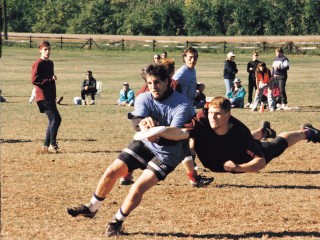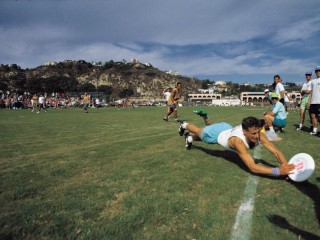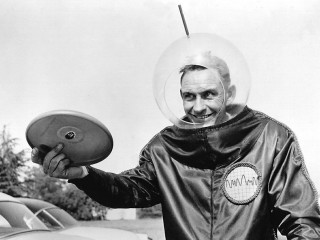By January 1990, the cavalcade was in full swing. The New York guys had a habit of blowing off steam for long, drunken periods of time during the winter months and they called it the “non-stop cavalcade of self-glorification.” It made up for all the hard work and performance-driven insanity that accompanied each player on the team’s unquenchable drive to Nationals. The ultimate season was not fun and the New Yorkers felt a shared sense of relief, not joy, after winning Nationals.
The city itself wasn’t very forgiving. The team was living in New York in the 1980s when crime, poverty and drugs were rampant. Times Square was a haven for pornography and heroin junkies. The murder rate in New York City was the highest in the nation and had been for as long as anyone could remember.
“You just lived through it,” said Dobyns. “All kinds of crazy shit happened. You watched your back, and you dealt with it.”
Half of the team seemed to live vagrant lives, settling into a loft in an abandoned area of downtown Brooklyn. The other half were stock brokers or lawyers, otherwise engaged in high-pressure work situations daily. For both sides, cocaine was a common drug of choice for an off-the-field nightlife. It’s well known that partying and playing good ultimate are not mutually exclusive and New York represented both sides quite well.
“We kind of lived a lifestyle,” said Dobyns. “We definitely partied. You just didn’t sleep a whole lot.”
“We weren’t a hard-alcohol drinking bunch,” said Blau. “But there were guys who smoked dope. The guys who smoked before they practiced, smoked before they played. You were either a smoker or a non-smoker and I think the better half were the smokers.”
New York was never mellow when they partook of the herb. At tournaments, they had a habit of amping up for play by drinking Jolt cola that they creatively modified to remove the CO2 by pouring it into Gatorade bottles and shaking the fizz off. Dobyns, Ben Usadi and others were well-known coffee addicts who carried canisters of fresh brew and slugged cups before games.
1990 was the year that New York was put to the task to defend their crown. As usual, the season began with a resounding tournament victory at Easterns, then considered to be the second-most competitive tournament in the country next to Boulder’s Fourth of July. At Easterns, they defeated Titanic, 21-12, extending a long precedent of New York and Boston beating everyone else before New York would defeat Boston in the finals. This happened three times in 1990 with wins at Easterns, the New York Invitational and Regionals. By the third finals match, Titanic had morphed into a team called First Time Gary.
“Boston always had a helluva team,” said New York’s Dan Weiss. “They were formidable and they had everything we had: Talented players, a drive to win, intelligence and leadership. Mooney was quite a leader and quite a player. But we always felt we had the psychological advantage.”
Later that summer, New York went on to win Worlds over Sweden 21-10, a more-or-less routine matchup between two great ultimate powers. Two months later at Nationals at the West Palm Beach Polo Club in Florida, the New Yorkers knocked Tsunami out and beat Boston’s First Time Gary, 19-12. From there it was inevitable.
“New York reached the finals by crushing over-matched Windy City, 21-9, while the Iguanas engaged in a mean-spirited, 43-goal marathon with First Time Gary, scoring the last two goals to win, 22-21, in semifinals,” wrote Scott Gurst in the Newsletter.
In the finals, New York showed zone most of the game and the Iguanas could not find a groove. The Iguanas’ Rich Gallagher completed 93 of 94 passes in the handle position, but a few key blocks were enough for New York to ride its patented highlight-reel offense to victory, 20-15. Dobyns, in particular, provided uplift for the team with several huge skies.
According to the statistics kept for the finals, Dobyns only attempted 10 passes, but he threw two of them for goals and caught five scores to lead all scorers. All 5’6” of Ken Dobyns was a dynamo on the field. He was unstoppable. After the game, Dobyns announced that he was going to retire from ultimate.
For close to 15 years, Ken Dobyns played the role of living legend. He was a menace on the field, capable of causing great pain to an opponent or to himself. One year he split his kidney on an attempted block and kept playing, coughing up blood when he sat down. An alert parent on the sideline had to guide him to a hospital and might have saved his life. In 1985, Dobyns tore his ACL during the semifinals of Nationals. He was carted off to the hospital but showed up the next day in a massive knee brace and played when the team made the finals. He reasoned that the tendon wasn’t necessary if the muscles were strong enough, and they were. In his mind, he was strong enough to do anything. His willpower was unprecedented.
“For me, in many ways, it was that I’ve always hated to lose more than I loved to win,” Dobyns said recently.
Dobyns’ personality was hardheaded yet hilarious. He could be a comical Napoleon blowing up in righteous indignation over perceived slights. He was a bully who needed the attention and got upset when the love wasn’t there. He was perceptive and humorous yet dangerously unstable at times. You never wanted to cross Ken Dobyns. “Dobyns is a force of nature,” said Pat King.
Dobyns’ commanding presence in the game defined ultimate’s lustful allure and addiction. He played the game rabidly. He didn’t retire in 1991. He still had too much blood left in him to spill on the field.








Comments Policy: At Skyd, we value all legitimate contributions to the discussion of ultimate. However, please ensure your input is respectful. Hateful, slanderous, or disrespectful comments will be deleted. For grammatical, factual, and typographic errors, instead of leaving a comment, please e-mail our editors directly at editors [at] skydmagazine.com.